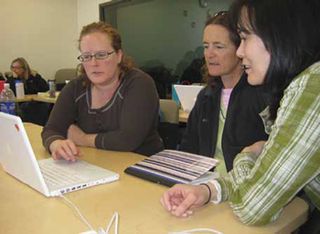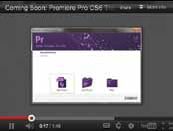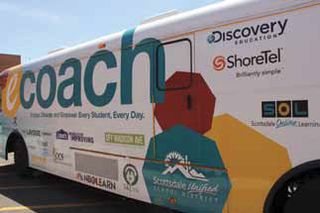Why should students have all the fun when it comes to learning? The following five districts have come up with innovative ways to deliver professional development opportunities to their teachers.
The Magic School Bus
Teachers hop aboard Scottsdale USD’s eCoach to learn how to use and integrate technology tools.Field trips aside, most teachers don’t willingly hop onto big yellow buses, but at Scottsdale Unified School District in Arizona, teachers are signing up to board the eCoach—an old bus that’s been converted into a modern mobile classroom using communications technology from ShoreTel. “Our district is really spread out, and it can take an hour or more to get to the district office or another facility for training,” says David Peterson, superintendent. “We wanted to bring the training to the teachers and students.” Schools fill out an online form to request training, such as the school nurses learning how to use the student information system, and the bus rolls up. “We even used it as an enrollment site,” says Tom Clark, chief technology officer. “We took the bus to a northern school for online kindergarten registration, saving parents the two-hour round trip visit to the enrollment office.”

The technology installed in eCoach replicates what’s in the classrooms, including a SMARTBoard, document camera, and wireless Internet access. As classrooms get new or upgraded tools, the eCoach will be updated as well, allowing staff and teachers to learn about the technology before they start using it. “One example is iPads, which are beginning to be used in classrooms in increasing numbers. By providing teachers with experience with iPads and some of the innovative apps that are available, they can learn what might work best in their learning environment,” says Clark.
It’s enough to make teachers want to “get on the bus!”
Ready for a Closeup?
When you’re providing training for 6,400 certified staff members, it’s nearly impossible to personalize it, but that’s what Kecia Ray does. Ray, executive director of learning technology for Metropolitan Nashville Public Schools (MNPS), offers face-to-face (F2F), online, and a combination of the two, depending on what makes sense and what the educators want. For Common Core training, MNPS started with F2F sessions and continued the process by creating instructional modules that were uploaded to Blackboard, the district’s learning management system. From there, teachers formed professional learning networks (PLNs) to continue their work.
Teachers from four Rhode Island districts attend a Teacher Technology Institute each summer.For online training, MNPS relies on Atomic Learning. Teachers watch Atomic Learning’s videos to improve their tech skills, such as how to use Microsoft products. But the icing on the cake is Atomic’s custom solution, which lets Ray upload her own videos and track their usage. “When one of our five instructional technologists sees a promising practice in a class, we capture it and add to our video library,” she says. “So far, we’ve got 400 videos—on everything from logging in to the network to starting a PLN—and we’re constantly adding more. Many of the videos have lesson plans attached to them.”

The numbers show that a lot of teachers are watching the videos, for personal edification or to fulfill their growth plans, and Ray is thrilled that they can do it when it’s convenient. Her latest acquisition is a 360-degree camera, which she’ll use to capture individual interactions.
Last year, three schools showed positive gains in writing and two came off the accountability list. “They attributed their success to our work with their teachers,” says Ray. “We’re all about helping teachers visualize their potential, and that only happens through embedded support from learning technology instructional designers.”
In the Moment
When Hillsborough County Public Schools in Florida wanted to provide algebra teachers with just-in-time coaching and support, they turned to MyLivePD. This program gives teachers immediate access to an online coach for help with classroom management, lesson planning, differentiated instruction, Common Core initiatives, student assessments, and more.
Douglas County teachers enjoy some collaborative learning time.For David Steele, chief information and technology officer at Hillsborough County Public Schools in Florida, MyLivePD fit right in with his plan to deliver PD in a non-traditional way. “It’s hard to find ways to train 12,500 teachers,” says Steele. “There are only so many Saturdays and week nights teachers want to give up.” A former math teacher himself, Steele liked the idea of a teacher talking with a professional about the next day’s lesson. As he says, “All the workshops about generalities won’t help me teach factoring tomorrow. This is the kind of individualized attention a teacher needs.”

Although Steele says it’s been challenging to get a large number of teachers to use it, the 200 who did gave it a very high rating. They used it for a total of 100 hours, and most of them stayed online for at least 30 minutes.
This year, Steele plans to hold more information sessions and target new hires, to increase awareness of this helpful resource.
The More, the Merrier
Looking for an innovative way to offer a wide variety of PD classes without spending a bundle? Take a lesson out of this consortium’s playbook.
For the last two summers, four Rhode Island districts held an extremely successful two-day Teacher Technology Institute. One district offered use of its new, tech-filled, spacious middle school, and teachers attended for free. Teachers who led sessions were paid by their own districts, to honor contractual obligations and eliminate varying pay rates. The four districts shared the costs for basic morning and afternoon refreshments, and teachers purchased or brought their own lunches.
Each session lasted two-and-a-half hours, and three or four sessions ran concurrently. Paul Barrette, director of technology at Burrillville School Department, created a Google Form for preregistration so the leaders could get a handle on numbers and, if necessary, add sessions.
To guarantee high participation, the leaders made sure each session featured tools that all four districts use. Some of the most popular offerings were Google Docs and collaboration, data analysis and presentation, and how to use online tools, such as blogs.
“It allowed us to offer a wider breadth than any one district could, and it was easier to fill workshops,” says Barrette. “In fact, several classes were over capacity.”
Not Just Child’s Play
If game-based learning is enticing and effective, why don’t we let teachers do it too?
At the Douglas County School District (DCSD) in Colorado, teachers play Bingo to personalize their PD. Here’s how it works: First, the district flips the learning by offering Bingo cards aligned to a variety of topics, such as connectivism, blended learning, and digital storytelling. Then teachers use the Bingo cards to continue learning independently and collaboratively.
“If you Google a topic like digital storytelling, you’ll get tons of links. So we created a Bingo card of resources for each topic,” says Kim McMonagle, director of educational technology. “The menu of options allows for personalization of learning styles and interests.” To get PD credit, the teachers learn, reflect, plan, create, and share their new skills.
The Bingo card for digital storytelling and podcasting, for example, includes eight different lessons and related activities. Each spot on the card includes links to learn a new skill, such as the NPR essays and podcasts on “This I Believe,” a personal essay project. One of the suggested activities for “This I Believe” is to join the global “This I Believe” project, a wiki in which classes share written essays and podcasts.
Teachers can also sign up for online courses in Moodle, Schoology, or Edmodo, take a webinar, do an independent project, such as creating a PLN, or attend a conference. Throughout all of these activities, teachers are mirroring what the district believes highly effective learning in the classroom should be: filled with higher-order thinking and real-world activities.
DCSD has been using this plan for about three years and McMonagle says teachers love it and are truly using what they’ve learned.
PD Tips on techlearning.com
Free video tutorials every Monday.
Introducing PinterestCommon Core State StandardsLearning Premiere Pro CS6Understanding Web 1.0




Should All Professional Development Be Like an Un-conference?
A little over two years ago, a small group of educational technologists in my area and I discussed the un-conference model for professional development (PD). We all thought that it had a lot of potential and that the Ed Camp un-conferences cropping up around the country were really great. So one of our group said that we should put together an unconference dealing with mobile devices, mainly tablets, and PadCamp was born.

This summer we held our second PadCamp at the southern New Jersey shore. More than 300 educators and students ran sessions and shared ideas and resources. They were hungry to learn and do it in a way that was productive and collaborative.
So, why aren’t more school districts holding their own un-conferences?
We have all gone through too many in-service days where the end result was boredom and frustration. Or people got so “off course,” that nothing productive came out of it. Many school districts have gone to the “turnkey” approach to PD where a few staff members go out and get trained and then come back to train their peers. Don’t get me wrong, this can be effective, but it could be better.
Just imagine a day when the staff walks into the school cafeteria or auditorium, with a blank schedule in hand, and are asked to create a PD day that they control. The thought of this makes many administrators cringe in fear. But, as professionals, we have a lot to share and sharing is what it’s all about. Remember, collaboration is a 21st century skill!
The un-conference model fosters sharing and collaboration. It gives a voice and platform for educators to share best practices and resources. I firmly believe that people would leave feeling empowered, excited, and motivated to go back and implement what they just learned. I have seen it in person and it’s too obvious not to stand up and pay attention.
The un-conference model of professional development gives everyone a voice and allows you to do what you do best—teach, learn, and collaborate.
Frank Pileiro is a Technology Coordinator in southern New Jersey.
The idea of an un-conference is nice: a conference with a loose theme like “Education Technology” where the participants create the agenda the day of the conference and present the attendees. All participants are involved in their own professional development: they set the agenda, they set the criteria for learning, and they essentially run everything. When they work, they work very well.

Frank Pileiro waxes poetic about his own experiences at Ed Camps and tries to let the reader imagine what it would be like if all PD followed that particular model. It would be cool if all staff development could be done that way. But what Pileiro forgets, I think, is that the people at Ed Camps are, for the most part, already motivated to be there, motivated to share, motivated to collaborate and learn. In other words, the Ed Camp people are the choir. They are already in church. How do you get the unmotivated to attend?
I suspect un-conference advocates would say that if you just made all staff development happen that way, then everyone would be motivated. But a lot of staff development that I have seen is information giving, often new information that no one other than a presenter has seen. How would you do an Ed Camp that teaches a specific technique if no one has ever seen that except the guest speaker? Indeed, many staff development sessions are held during faculty meetings, Professional Learning Community meetings, and after school. All of these have time constraints, and while maybe not the best for in-depth professional development, are the norm in many districts and campuses. (How can you spend an hour working on the agenda when your entire staff development may only be an hour?)
While I like the idea of having an Ed Camp-like staff development, this is something that is so far removed from MOST teachers’ professional development experiences it will require a bit of time to acclimate them to moving to this model.
THAT would be an interesting discussion: how to get teachers to move to the Ed Camp model. How would you do it?
Tim Holt has been in the education field for over 25 years, first as a teacher, then an education facilitator, a researcher, and a Director of Instructional Technology.

